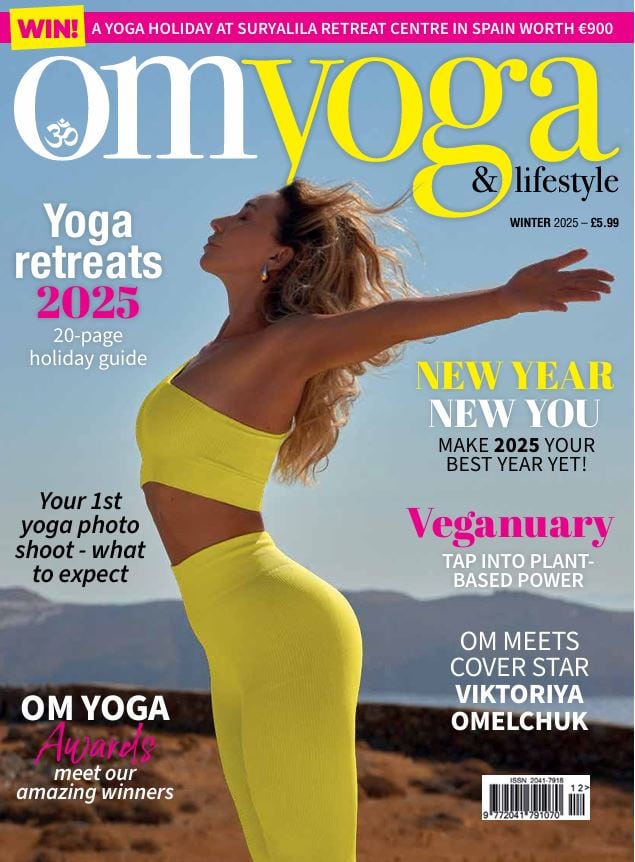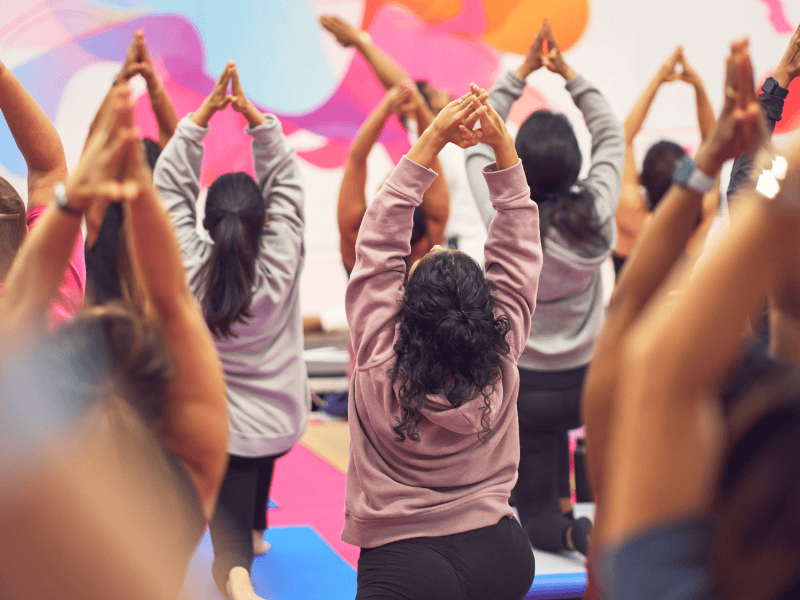
The power of two
The benefits of partner yoga: 8 poses to explore with a partner. By Elisa ‘Eli’ van der Pol and Patrick ‘Pat’ van der Pol
Discover the magic of connection with this invigorating partner yoga sequence. Below are a few introductory yoga poses to explore with a partner, ranging from simple to more challenging. If your partner is significantly different in height, it may take a little longer to find shapes that work for you, but this is part of the fun. Keep communicating, enhance trust and enjoy the journey of building strength and flexibility together. Relax, and don’t take it too seriously!
Yoga is typically a solo activity. You arrive on your mat, practice your postures, tune into your breath, and if you're lucky, experience the joy of deep self-connection. But what happens when you bring another person into that experience? A whole new realm of exploration opens up.
Physically working with another body can help you move deeper into postures and provide sensory feedback about your body’s alignment. Your partner can support balance and stability. On an emotional and spiritual level, practicing with someone allows you to deepen your experience by integrating theirs. Connecting with another person’s practice enhances your own. Most importantly, partner yoga is a lot of fun!
Navigating the challenges of different body types and balance issues adds playfulness to your practice. It’s a perfect way to bond with old friends or make new ones. Some even believe it can improve intimacy and communication in relationships.
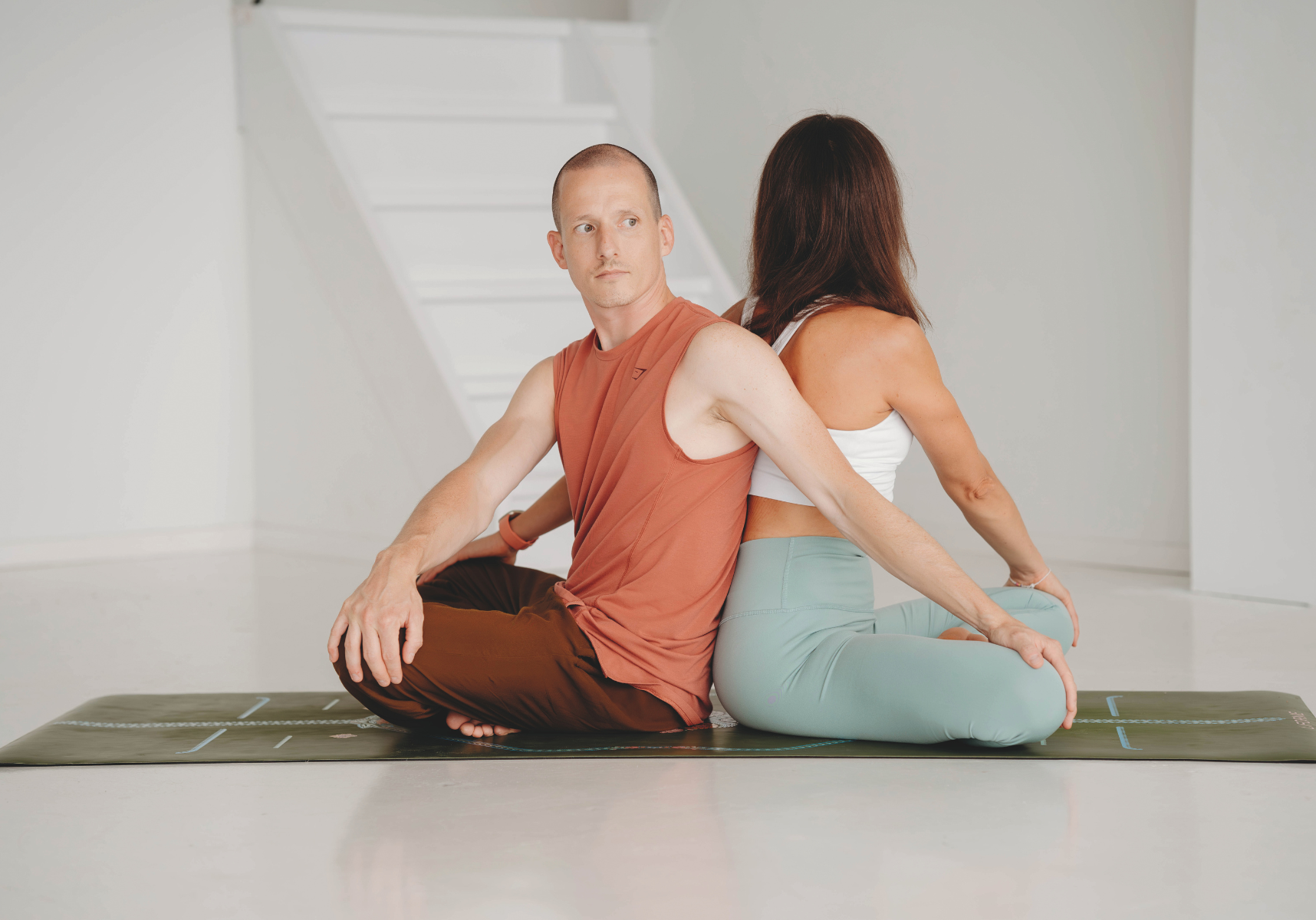
1. Parivrtta Sukhasana (Revolved Easy Pose)
How to enter: Start seated back-to-back with your partner in a comfortable cross-legged position. Both of you raise your right hands and place them on your left knees, palms down. Stretch your left arms out to the left and place them on your partner’s right knee. Take a deep breath together and, as you exhale, twist to your left as far as you comfortably can. Stay for 4-5 breaths. Inhale to return to centre, and repeat on the other side.
Benefits: Twisting poses help improve spinal flexibility and aid in digestion. The support from your partner deepens the twist and enhances the stretch
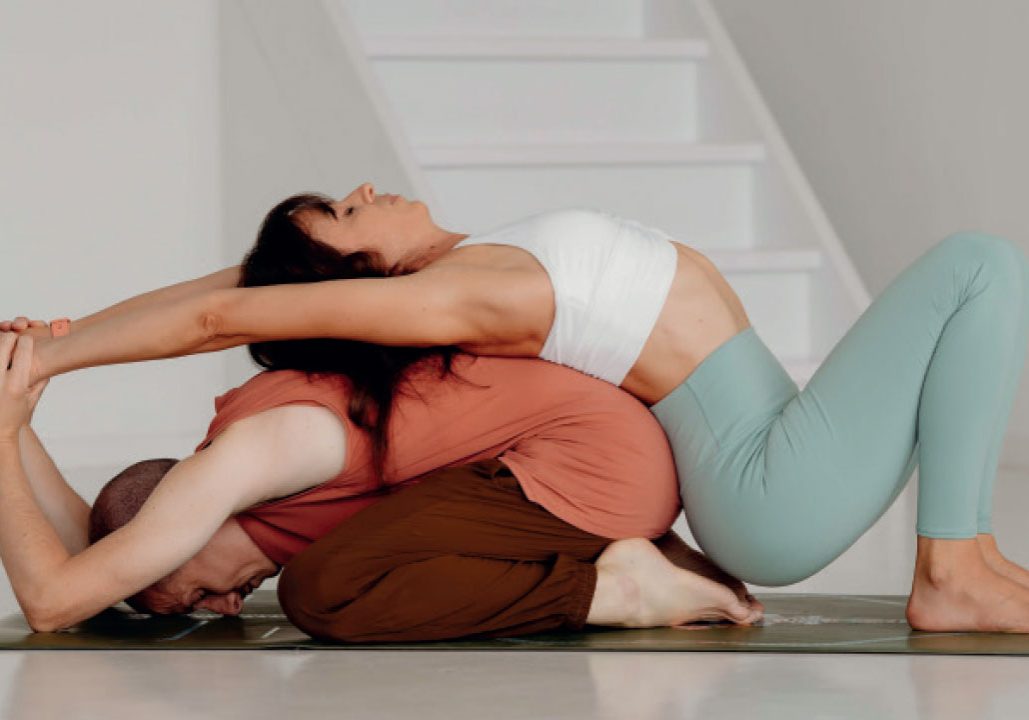
2. Balasana (Child Pose) and Backbend Assist
This is a surprisingly restorative experience for both partners. Make sure you switch roles after trying it so you both experience all the benefits. Be aware that if either of you has any knee tenderness in child's pose, you may want to give this one a miss.
How to enter: One partner comes into an extended Child’s Pose with arms stretched out in front. The other partner sits gently on the lower back, aligns their pelvis, and carefully lowers onto their back, creating a supported backbend. For an added stretch, the person in the backbend can extend their arms or legs. Switch roles after a few breaths. If you are much taller than your partner, you might need to move your hips a bit lower. Keep communicating throughout the process. Once you are lying down over their back, you can extend your arms over your head. Perhaps your partner can hold your wrists, helping you to experience a shoulder opening while enjoying a delicious supported backbend. To feel even more of an opening, you can also extend your legs straight. Your partner will benefit from a grounding lower back release. Hold for 5-10 breaths.
Benefits: The person in Child's Pose experiences a grounding lower back release, while the partner in the backbend enjoys a deep chest and shoulder opening.
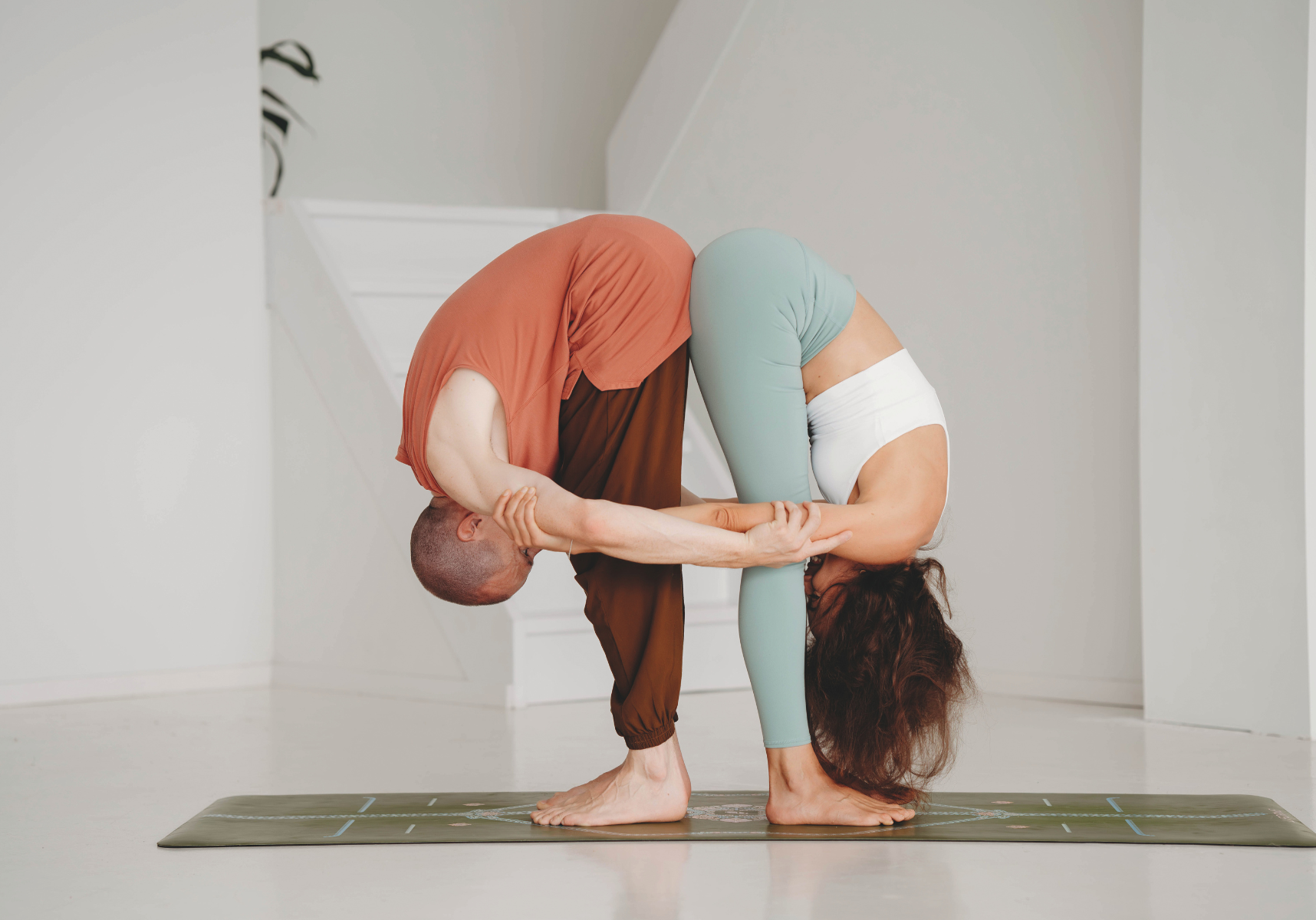
3. Uttanasana (Intense Spine Stretching Pose)
Deepen your forward fold with the support of your partner for balance. Bonus points if you make faces at each other through your legs!
How to enter: Stand back-to-back with your partner, with your heels about 15cm apart. Begin by folding forward at the hips, allowing your upper body to hang down. If needed, bend your knees slightly for comfort. Reach your arms behind your legs and grab the front of your partner’s arms. Your partner will do the same. Gently pull on each other’s arms to deepen the stretch. Stay here for at least five slow breaths, then carefully release.
Benefits: This partner-supported forward fold enhances flexibility in the hamstrings, calves, and lower back. The mutual pull helps you deepen the stretch safely, while providing support for balance.
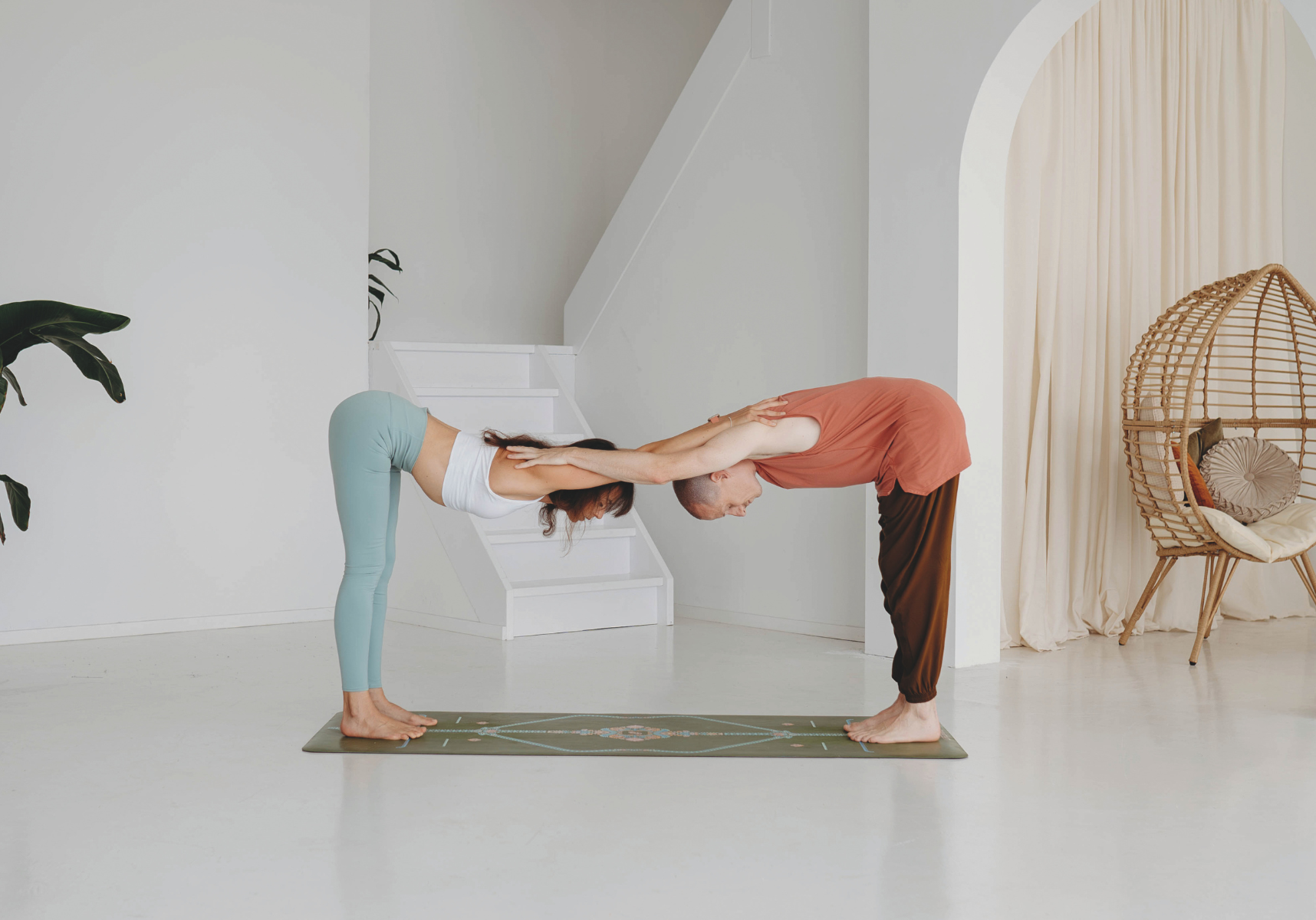
4. Ardha Uttanasana (Standing Forward Bend)
How to enter: Stand facing your partner, about a metre apart, with feet parallel and hip-width. Bend forward at the hips and place your hands on each other’s shoulders. If necessary, to extend your legs and back further, move further apart so the pelvis moves back from the flatness of the feet. Press your shoulders, stretching even more with your spine, extending your chest muscles and shoulder joints. Hold for 4 to 8 breathing cycles.
Benefits: This pose stretches the hamstrings, calves, and back, while the support helps maintain alignment.
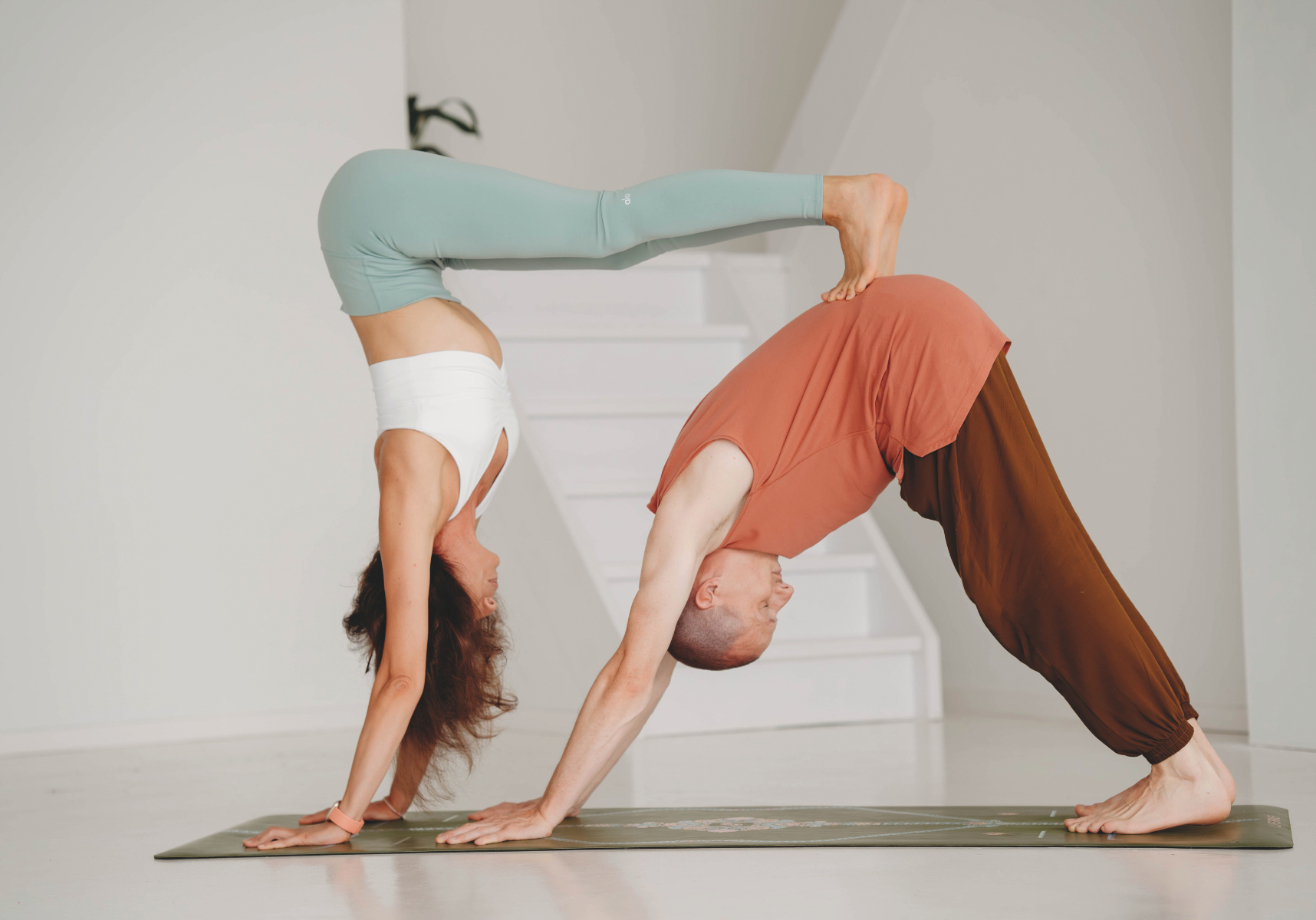
5. Ardha Adho Mukha Vrksasana (Half Handstand) And Adho Mukha Svanasana (Downward-facing Dog)
This is quite a challenging posture for this little set, but it’s actually much easier than it sounds and can feel great for both partners.
How to enter: Have your partner come into Adho Mukha Svanasana, and make sure they feel stable. Bring your feet to the outsides of their hands, facing away from them, then place your hands on the ground about a foot in front of their hands. One foot at a time, step your feet up onto the outsides of your partner’s lower back and straighten your legs to bring your hips over your shoulders for Ardha Adho Mukha Vrksasana. The balls of your feet should find the bony landmarks at the top of your partner’s pelvis, well away from their spine. This will give them a lovely lower back release, and because most of your weight is in your hands, you get to build upper body strength too, while they’ll be amazed by how light you feel. To come out, step down one foot at a time – no jumping.
Benefits: The partner in the handstand builds upper body strength, while the partner in Downward Dog enjoys a release in their lower back and hamstrings.
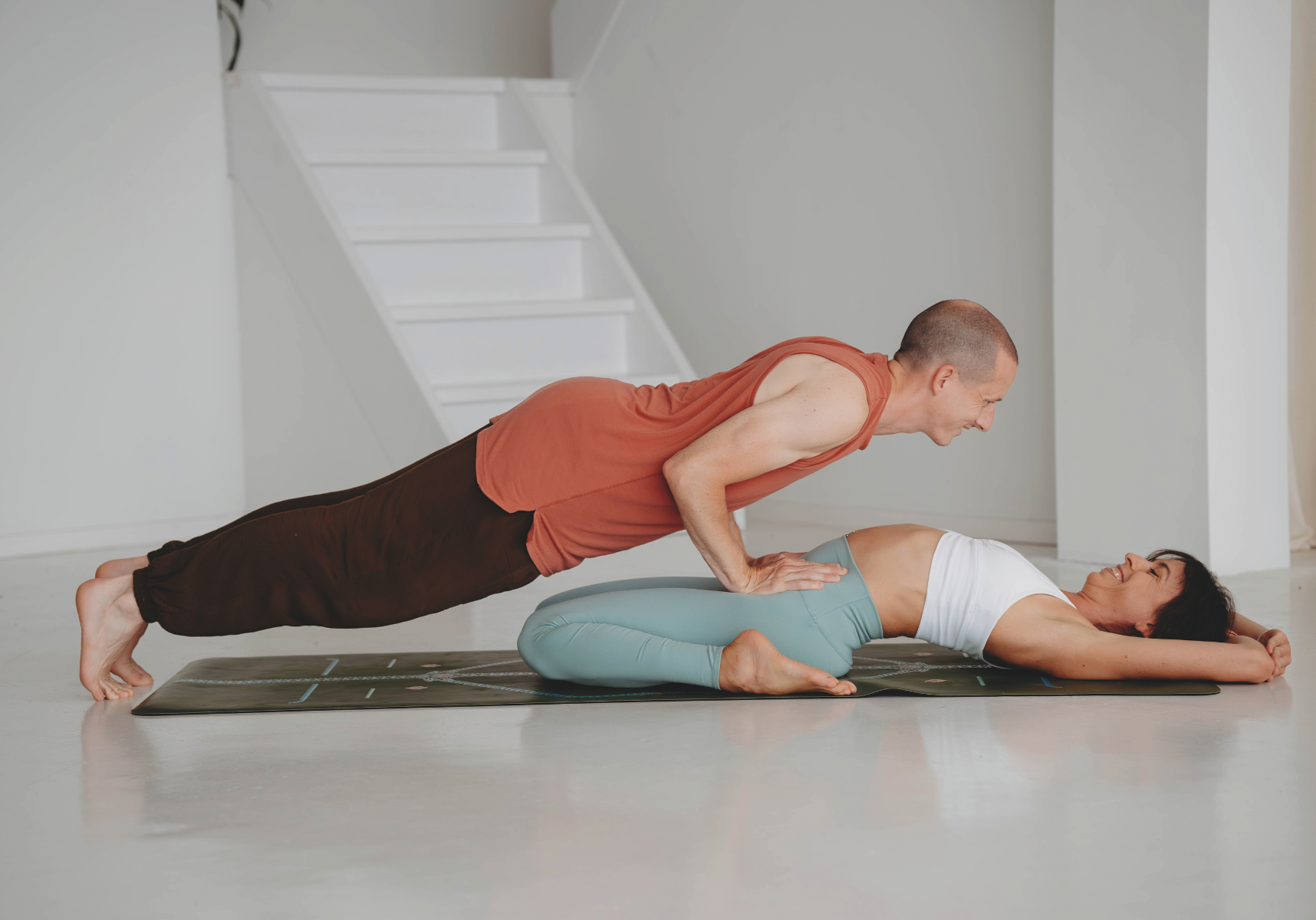
6. Supta Virasana And Chaturanga Dandasana (Lying Hero Pose And Four-Limbed Staff Pose)
How to enter: Supta Virasana: One partner sits on his/her heels with the knees bent. Be careful with your knees, make sure the inward rotation is happening at the hips. Then sit on your buttocks, releasing your calf muscle and placing your feet side of your thighs. Get down on your elbows, then, as you exhale, on your back, put your arms on the floor behind you. Arms options: straight or catching the elbows.
Chaturanga Dandasana: The second partner bends down and places his/her palms, fingers forward, on the partner’s thighs below the ilium. Then he/she steps back, placing the feet parallel to each other, hip-width apart. While inhaling, he/she makes the body into a straight line, while exhaling, lowers the body into the plank position by bending the elbows directly backwards, forming the final shape of chaturanga dandasana.
Benefits: This pose combination strengthens the core, shoulders, and arms, while providing a deep quadriceps stretch for the partner in Supta Virasana.
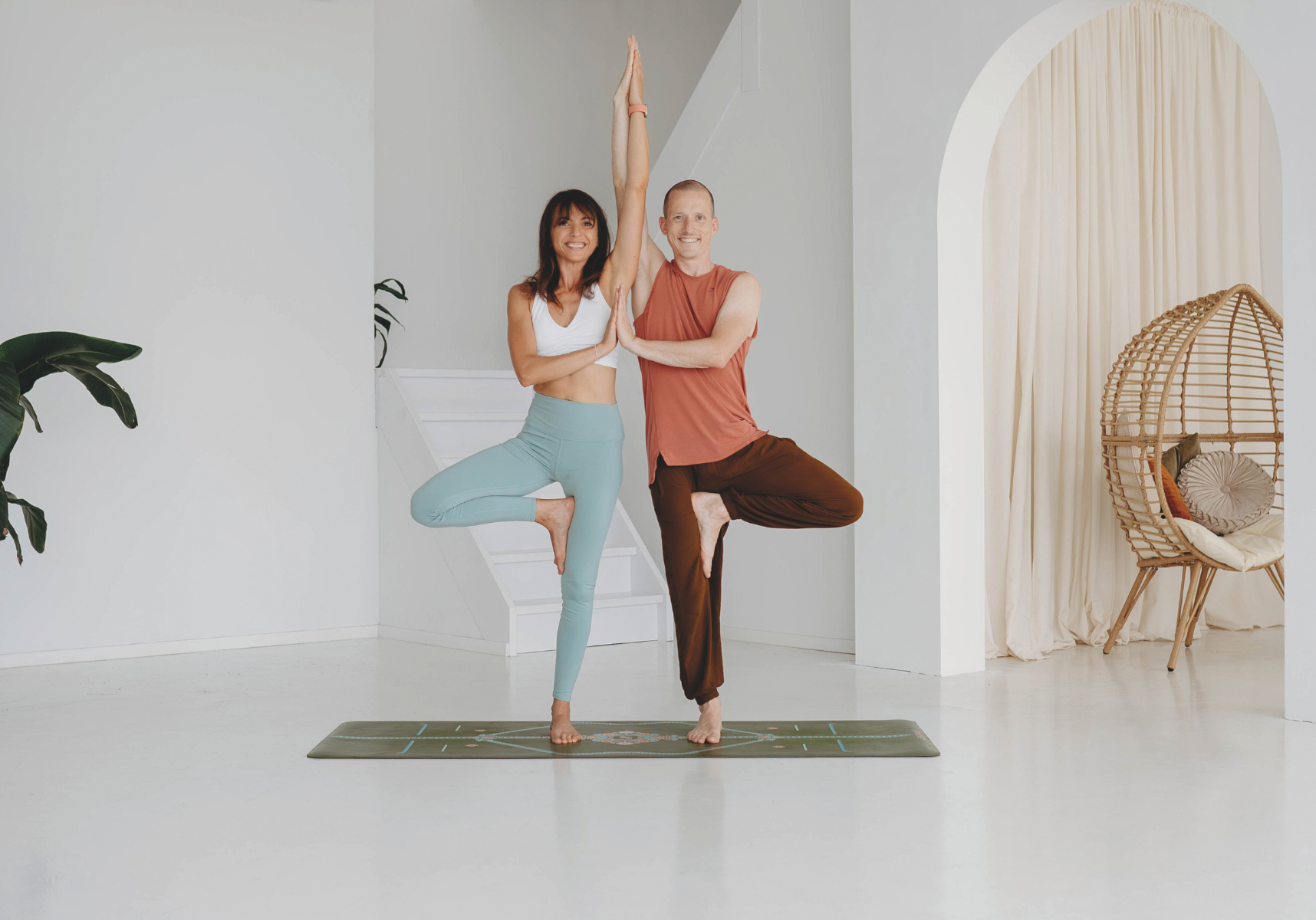
7. Vrksasana (Tree Pose)
This is such an enjoyable way to practice Tree Pose, with your fellow tree to support your balance!
How to enter: Stand side by side, hip to hip, and wrap your arms around each other’s waists. Bring your outside leg into Tree Pose, placing the sole of your foot on the opposite inner thigh, and your outside hand to join your partner’s opposite hand in a prayer position in front of your chests. Press your palms together and feel yourself rooting into the ground, supported graciously by your partner tree. You can then grow your trees together by reaching your outside hands up overhead crossing wrists. Experiment also by gently moving together as if swaying in a breeze. See how different having your partner there makes the balancing experience!
Benefits: This pose improves balance and coordination, and the partner support enhances stability.
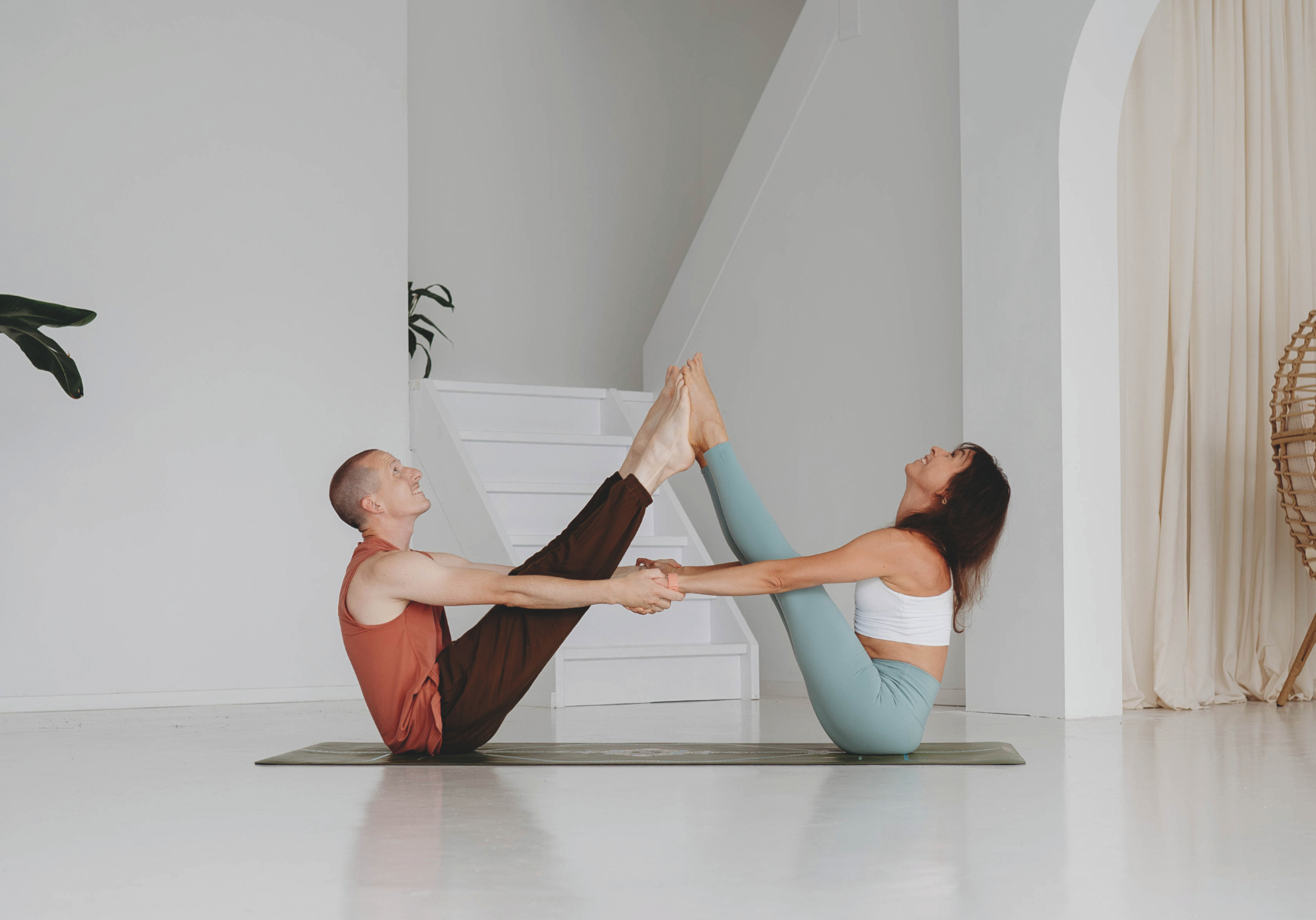
How to enter: Sit facing your partner with your knees bent. Reach out and clasp your partner’s hands or wrists (clasping hands will give you a little more room to manoeuvre your legs, but clasping wrists provides a little more stability). Lift one foot off the ground while your partner lifts the opposite foot off the ground. Press the sole of your foot against the sole of your partner’s foot, keeping your right knees inside your arms. Begin to straighten the knee. Repeat on the other side. Once both feet are up, you can work on straightening the legs. Make sure to use your core muscles to hold yourself up as you would in a regular boat pose. Work playfully with the pose, have fun, and don’t forget to breathe. Come down slowly, one foot at a time, and release your hands.
Benefits: This pose strengthens the core muscles, improves balance, and encourages cooperation and communication between partners.
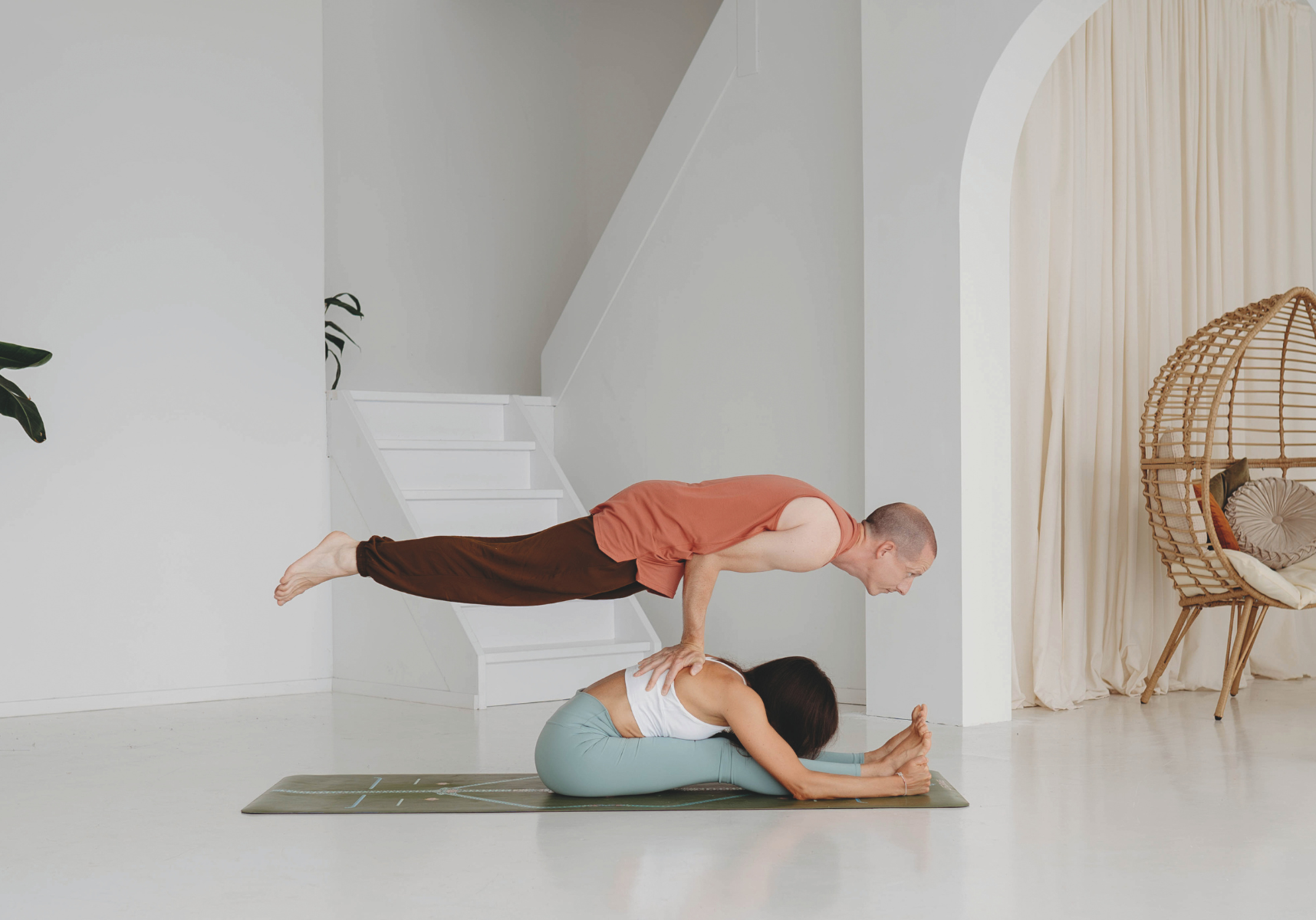
9. Paschimottanasana (Seated Forward Bend) And Mayurasana (Peacock Pose)
This is a challenging pose, so ensure you are comfortable with Mayurasana before trying the partner version. Partner in Paschimottanasana: Lean forward and hold your feet from the outside, pulling your torso towards your legs. Partner in Mayurasana: Find a stable position for your palms on your partner's back. Place your palms next to each other in the centre of their back, with fingers pointing backwards and wrists turned inwards. Slide your elbows towards the centre and bring your forearms together. As you exhale, with a top-down movement, place your torso on the bent elbows so that the back sides of the shifted shoulder could rest against the chest, and the elbows against the centre of the abdomen. Raise your head, pull your chin forward, and move your shoulder joints back. Find balance and lift your legs into the air, bringing them together. Pull the whole body in one line parallel to the floor with a chin forward and the feet back. Time depends on strength and balance.
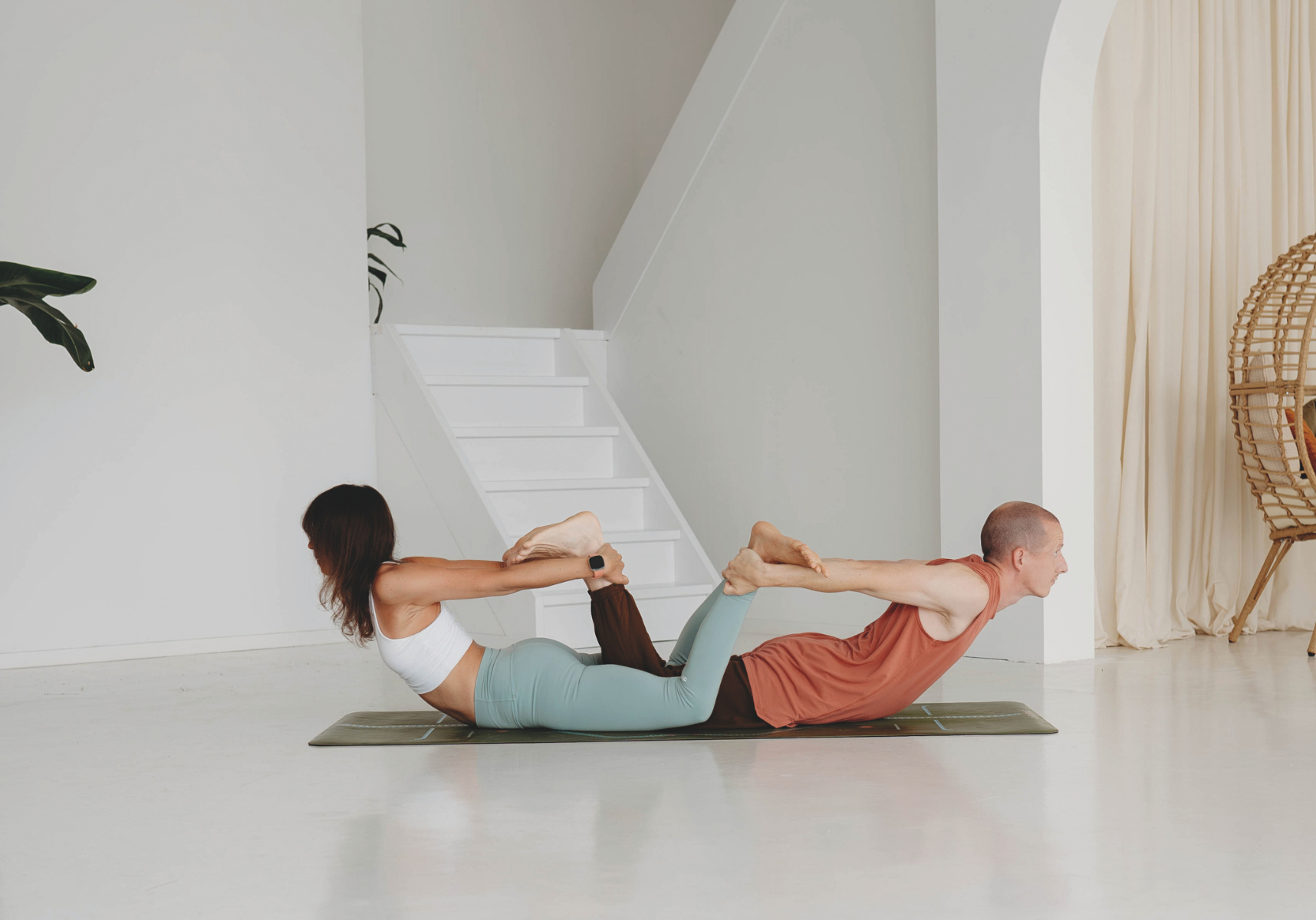
10. Dhanurasana (Bow Pose) Partner Variation
How to do it: Both partners lie on their stomachs, feet facing each other. Move toward each other until one partner’s knees are between the other’s knees. Press your legs together firmly. Bend your knees and reach back to grab your partner’s ankles, while they do the same. Both partners bend their ankles at a 90º angle. As you exhale, lift your chests off the ground, pulling on each other’s ankles to deepen the backbend. Engage your legs and core, keeping your hips on the floor. Avoid bending your elbows and focus on opening the chest by using the strength of your legs to pull on your partner’s arms.
Benefits: This pose strengthens the back, legs, and glutes while deeply stretching the chest and shoulders. Working with a partner enhances the stretch by creating a mutual pulling action that deepens the backbend.
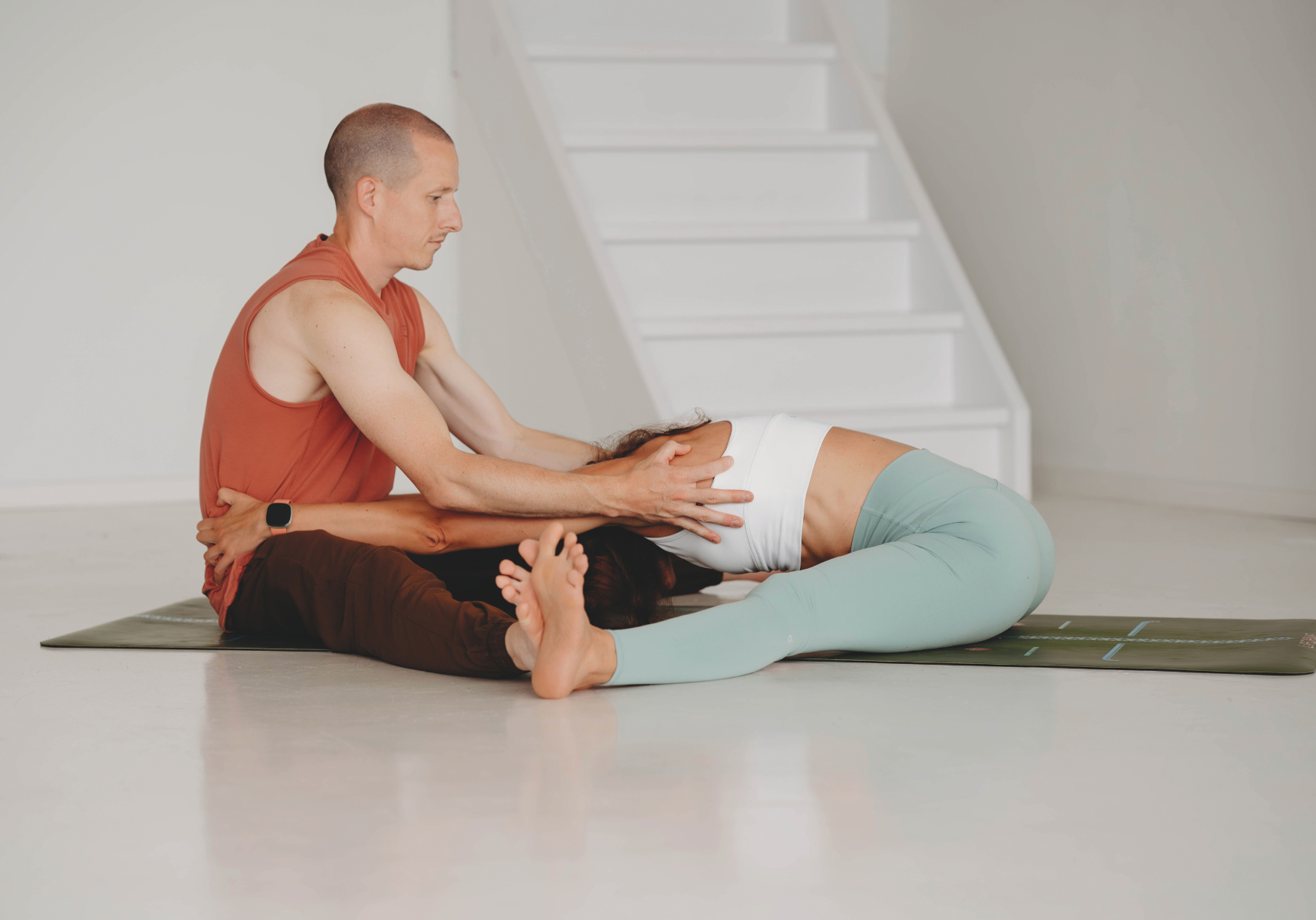
11. Upavistha Konasana (Seated Straddle Pose)
This pose is great for enhancing flexibility and providing mutual support in the stretch.
How to enter: Sit facing your partner with both your legs stretched out wide. Bring the soles of your feet to touch your partner's. Inhale, hold each other's hands in front of the chest, and try to sit up nice and tall. Begin to coordinate the breath and movement: one partner exhales and folds forward, reaching for the other partner’s hips, feeling a stretch in their hamstrings and groin. The other partner inhales and slowly lifts and gently pulls the forward[1]bending partner's shoulders, enhancing the fold and supporting an increased depth in the stretch. Ensure to be gentle and easy throughout the process. For the partner folding forward, try to bend from the hip to prevent rounding of the spine. Stay for about six breaths. A soft bend in the knees may be helpful if the forward-folding partner is experiencing any discomfort. Use gentle pressure and support to enhance the stretch and connection between partners.
Benefits: This pose stretches the inner thighs, hamstrings, and lower back, while the partner support enhances the depth of the stretch.
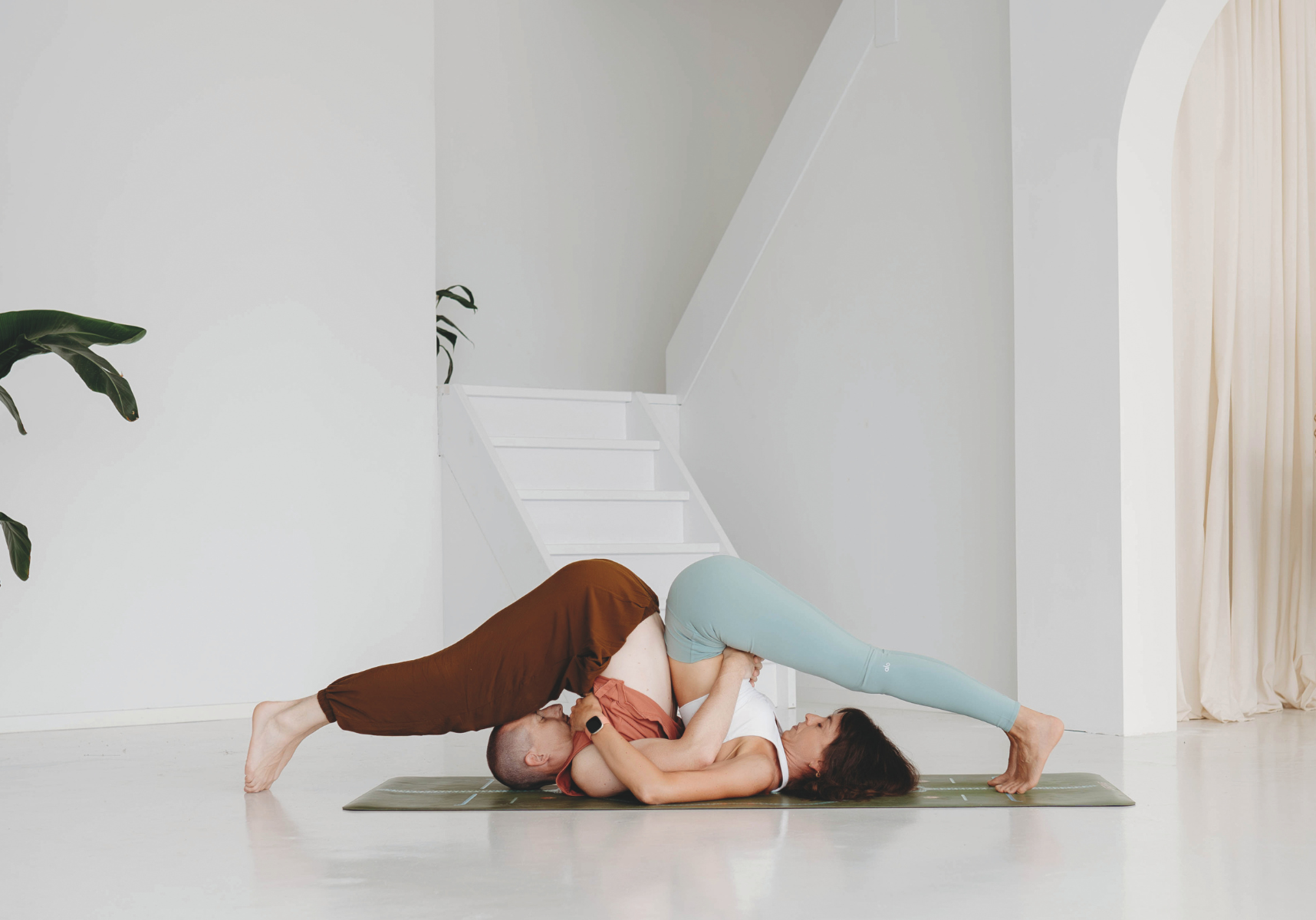
12. Halasana (Plough Pose)
How to enter: Partner A begins in Supported Shoulderstand Pose (Sarvangasana), with their back on the mat and legs extended vertically. Partner B lies on their back with their feet placed on Partner A’s thighs. Partner B then lifts their legs overhead into Halasana (Plough Pose), bringing their toes toward the floor behind their head. At the same time, Partner A maintains their Shoulder Stand position and supports Partner B’s legs by keeping them aligned and stable. Partner A then slowly transitions into Halasana by bringing their feet toward the floor behind their head, mirroring Partner B’s position. Both partners’ backs remain in contact throughout the movement, providing mutual support. Communication is key to ensure stability and balance in this double version of Plough Pose.
Benefits: This pose stretches the shoulders, spine, and hamstrings. The mutual support enhances alignment and deepens the stretch for both partners. It also encourages trust and synchronisation.
Elisa ‘Eli’ van der Pol is an E-RYT 500 and a YACEP. She teaches Hatha, Vinyasa, mobility, and functional asana, creating a space for people to challenge their comfort zones, explore their boundaries, and connect with their inner playful child. Visit: movewitheli.com or connect on IG @movewitheli
Patrick ‘Pat’ van der Pol is an E-RYT 500 and a YACEP. He teaches Hatha, Vinyasa, breathwork and meditation, designing a space for personal growth, self-realisation, self-healing and the expansion of our consciousness. Connect on IG @yogabreathevolution
Together, Eli and Pat organise and host retreats @wildsoulsretreats across the globe (wildsouls-retreats.com) Eli and Pat also offer courses and teacher training* through their Move and Breathe Academy (movebreatheacademy.com) or practice online with them on YouTube at Move Breathe with Pat & Eli @moveandbreathe)
* Only for OM readers: until the end of November 2025, you can benefit from a €150 discount by using code OM150 in the comments while booking


